An Injectivity Evaluation Model of Polymer Flooding in Offshore Multilayer Reservoir
Abstract
:1. Introduction
2. Physical Model and Basic Assumptions
- (1)
- The seepage medium is homogeneous, isotropic, and incompressible.
- (2)
- The displacement is non-piston like with a constant injection rate.
- (3)
- The gravity, capillary force, and fluid diffusion are negligible.
- (4)
- The constitutive equation of the polymer solution as non-Newtonian fluid follows the power-law model.
- (5)
- The polymer solution is divided into two phases: a polymer phase and an oil phase. This polymer is only soluble in water and insoluble in oil.
- (6)
- The polymer solution only reduces the relative permeability of the water phase without changing that of the oil phase.
- (7)
- The fluid flow follows the generalized Darcy’s law, and the cross flow is not considered.
3. Mathematical Model
3.1. Fluid Saturation Distribution in Polymer Flooding
3.1.1. Frontal Saturation in Polymer Single-Phase Flow Region
3.1.2. Frontal Saturation in Oil Bank Region
3.1.3. Breakthrough Time of Displacement Front
3.2. Pressure Difference between Injector and Producer
3.2.1. Pressure Difference between Injector and Producer in Water Flooding
3.2.2. Pressure Difference between Injector and Producer in Polymer Flooding
3.3. Zonal Flow Rate in Multilayer Reservoir
3.4. Injectivity of Polymer Flooding in Multilayer Reservoir
4. Results and Discussion
4.1. Model Validation
4.2. Injectivity Evaluation of Polymer Flooding
4.3. Effect of Injection Parameters on Injectivity
5. Conclusions
Author Contributions
Funding
Acknowledgments
Conflicts of Interest
References
- Mogbo, O.C. Polymer flood simulation in a heavy oil field: Offshore Niger-delta experience. In Proceedings of the SPE Enhanced Oil Recovery Conference, Kuala Lumpur, Malaysia, 19–21 July 2011. [Google Scholar]
- Ma, K.Q.; Li, Y.L.; Wang, L.L.; Zhu, X.L. Practice of the early stage polymer flooding on LD offshore oilfield in Bohai bay of China. In Proceedings of the SPE Asia Pacific Enhanced Oil Recovery Conference, Kuala Lumpur, Malaysia, 11–13 August 2015. [Google Scholar]
- Morel, D.C.; Vert, M.; Jouenne, S.; Gauchet, R.; Bouger, Y. First polymer injection in deep offshore field Angola: Recent advances in the Dalia/Camelia field case. In Proceedings of the SPE Annual Technical Conference and Exhibition, Florence, Italy, 19–22 September 2010. [Google Scholar]
- Liu, R.; Jiang, H.Q.; Zhang, X.S. Effective characteristics of early polymer flooding in mid-to-low viscosity offshore reservoir. Acta Pet. Sin. 2010, 31, 280–283. [Google Scholar]
- Kaminsky, R.D.; Wattenbarger, R.C.; Szafranski, R.C.; Coutee, A.S. Guidelines for polymer flooding evaluation and development. In Proceedings of the International Petroleum Technology Conference, Dubai, UAE, 4–6 December 2007. [Google Scholar]
- Kang, X.D.; Zhang, J.; Sun, F.J.; Zhang, F.J.; Feng, G.Z.; Yang, J.R.; Zhang, X.S.; Xiang, W.T. A review of polymer EOR on offshore heavy oil field in Bohai Bay, China. In Proceedings of the SPE Enhanced Oil Recovery Conference, Kuala Lumpur, Malaysia, 19–21 July 2011. [Google Scholar]
- Cao, B.G.; Luo, P.Y. An experimental study on rheological properties of the associating polymer solution in porous medium. Acta Pet. Sin. 2011, 32, 652–657. [Google Scholar]
- Jiang, W.D.; Kang, X.D.; Xie, K.; Lu, X.G. Degree of the association of hydrophobically associating polymer and its adaptability to the oil reservoir. Pet. Geol. Oilfield Dev. Daqing 2013, 32, 103–107. [Google Scholar]
- Ren, K.; Jiang, G.Y.; Xu, C.M.; Lin, M.Y.; Luo, M.Q. Solution conformation of hydrophobically associating polymers. J. Univ. Pet. China 2005, 29, 117–120. [Google Scholar]
- Taylor, K.C.; Nasr-El-Din, H.A. Hydrophobically associating polymers for oil field applications. In Proceedings of the Canadian International Petroleum Conference, Calgary, AB, Canada, 12–14 June 2007. [Google Scholar]
- Xie, X.Q.; Zhang, X.S.; Feng, G.Z.; He, C.B. Analysis on injection pressure of polymer flooding: A case study from a oilfield in Bohai Sea. Fault-Block Oil Gas Field 2012, 19, 195–198. [Google Scholar]
- Xie, K.; Lu, X.G.; Li, Q.; Jiang, W.D.; Yu, Q. Analysis of reservoir applicability of hydrophobically associating polymer. SPE J. 2016, 21, 1–9. [Google Scholar] [CrossRef]
- Lake, L.W. Enhanced Oil Recovery; Prentice Hall: Upper Saddle River, NJ, USA, 1989; pp. 332–338. [Google Scholar]
- Seright, R.S. The effects of mechanical degradation and viscoelastic behavior on injectivity of polyacrylamide solutions. SPE J. 1983, 23, 475–485. [Google Scholar] [CrossRef]
- Shuler, P.J.; Kuehne, D.L.; Uhl, J.T.; Walkup, G.W., Jr. Improving polymer injectivity at west coyote field, California. SPE Reserv. Eng. 1987, 2, 271–280. [Google Scholar] [CrossRef]
- Buell, R.S.; Kazemi, H.; Poettmann, F.H. Analyzing injectivity of polymer solutions with the Hall plot. SPE Reserv. Eng. 1990, 5, 41–46. [Google Scholar] [CrossRef]
- Buell, R.S. Analyzing Injectivity of Non-Newtonian Fluids: An Application of the Hall Plot; Arthur Lakes Library, Colorado School of Mines: Golden, CO, USA, 1986. [Google Scholar]
- Liu, M.M.; Jiang, R.Z.; Xing, Y.C.; Yu, C.C.; He, W. Research on the injectivity of polymer solution. In Proceedings of the 13th National Congress on Hydrodynamics & 26th National Conference on Hydrodynamics, Qingdao, Shandong, China, 22–27 August 2014; pp. 879–887. [Google Scholar]
- AlSofi, A.M.; Blunt, M.J. Control of numerical dispersion in streamline-based simulations of augmented waterflooding. SPE J. 2013, 18, 1102–1111. [Google Scholar] [CrossRef]
- AlSofi, A.M.; Blunt, M.J. Streamline-based simulation of non-Newtonian polymer flooding. SPE J. 2010, 15, 895–905. [Google Scholar] [CrossRef]
- Jain, L.; Lake, L.W. Surveillance of secondary and tertiary floods: Application of Koval’s theory to isothermal enhanced oil recovery displacement. In Proceedings of the SPE Improved Oil Recovery Symposium, Tulsa, OK, USA, 12–16 April 2014. [Google Scholar]
- Koval, E.J. A method for predicting the performance of unstable miscible displacement in heterogeneous media. SPE J. 1963, 3, 145–154. [Google Scholar] [CrossRef]
- Seright, R.S. How much polymer should be injected during a polymer flood? In Proceedings of the SPE Improved Oil Recovery Conference, Tulsa, OK, USA, 11–13 April 2016. [Google Scholar]
- Luo, H.; Li, Z.; Tagavifar, M.; Lashgari, H.; Zhao, B.C.; Delshad, M.; Pope, G.A.; Mohanty, K.K. Modeling polymer flooding with crossflow in layered reservoirs considering viscous fingering. In Proceedings of the SPE Canada Heavy Oil Technical Conference, Calgary, AB, Canada, 15–16 February 2017. [Google Scholar]
- Lu, X.A.; Liu, F.; Liu, G.W.; Pei, Y.L.; Jiang, H.Q.; Chen, J.S. A polymer injectivity model establishment and application for early polymer injection. Arab. J. Sci. Eng. 2018, 43, 2625–2632. [Google Scholar] [CrossRef]
- Zhang, F.J. The optimum early polymer injection time for offshore heavy oil reservoir. China Offshore Oil Gas 2018, 30, 89–94. [Google Scholar]
- Wang, J.M.; Chen, G.; Li, Y.; Ma, M.R. A kinetic mechanism study on oil bank forming during polymer flooding. Pet. Geol. Oilfield Dev. Daqing 2007, 26, 64–66. [Google Scholar]
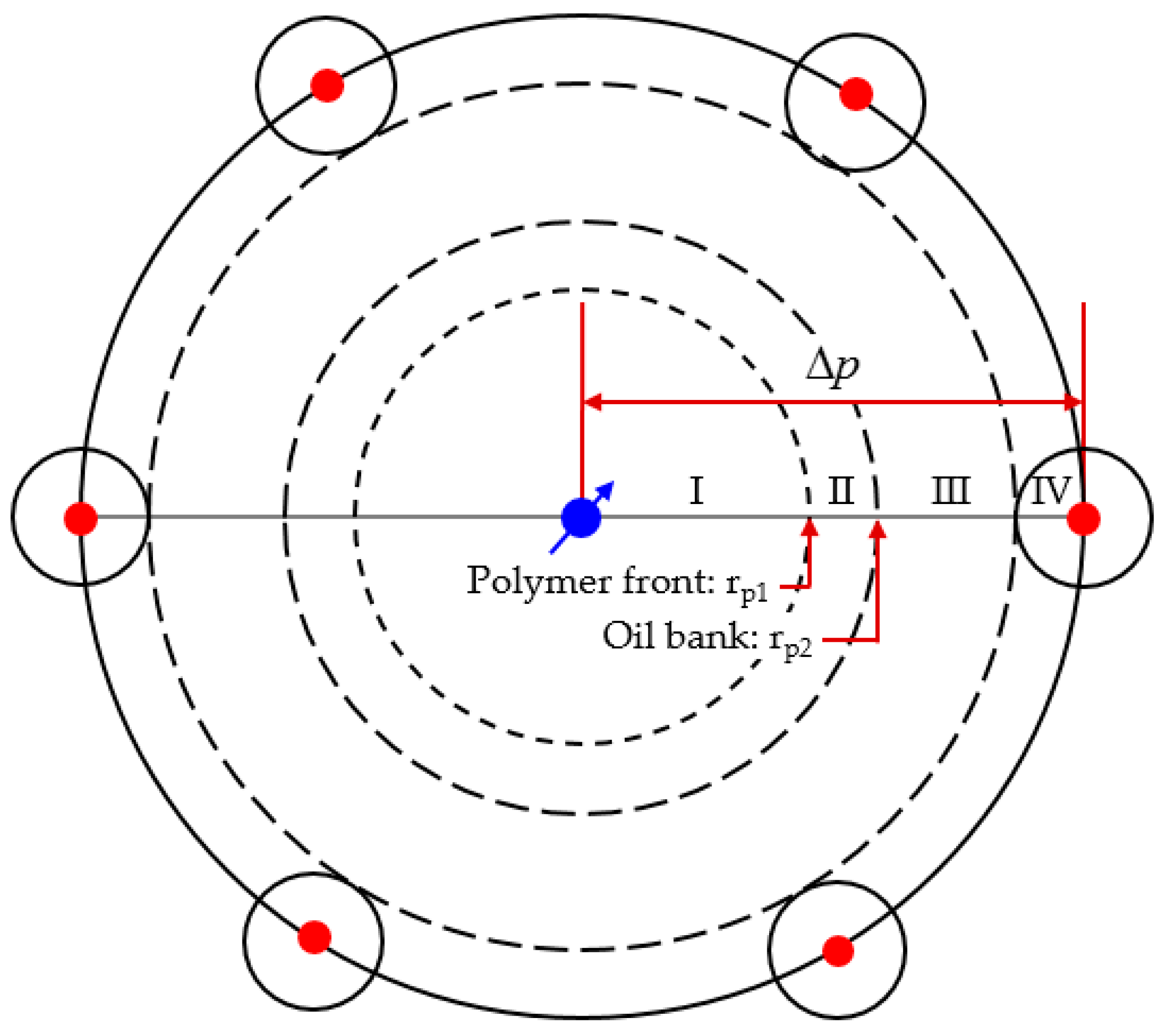
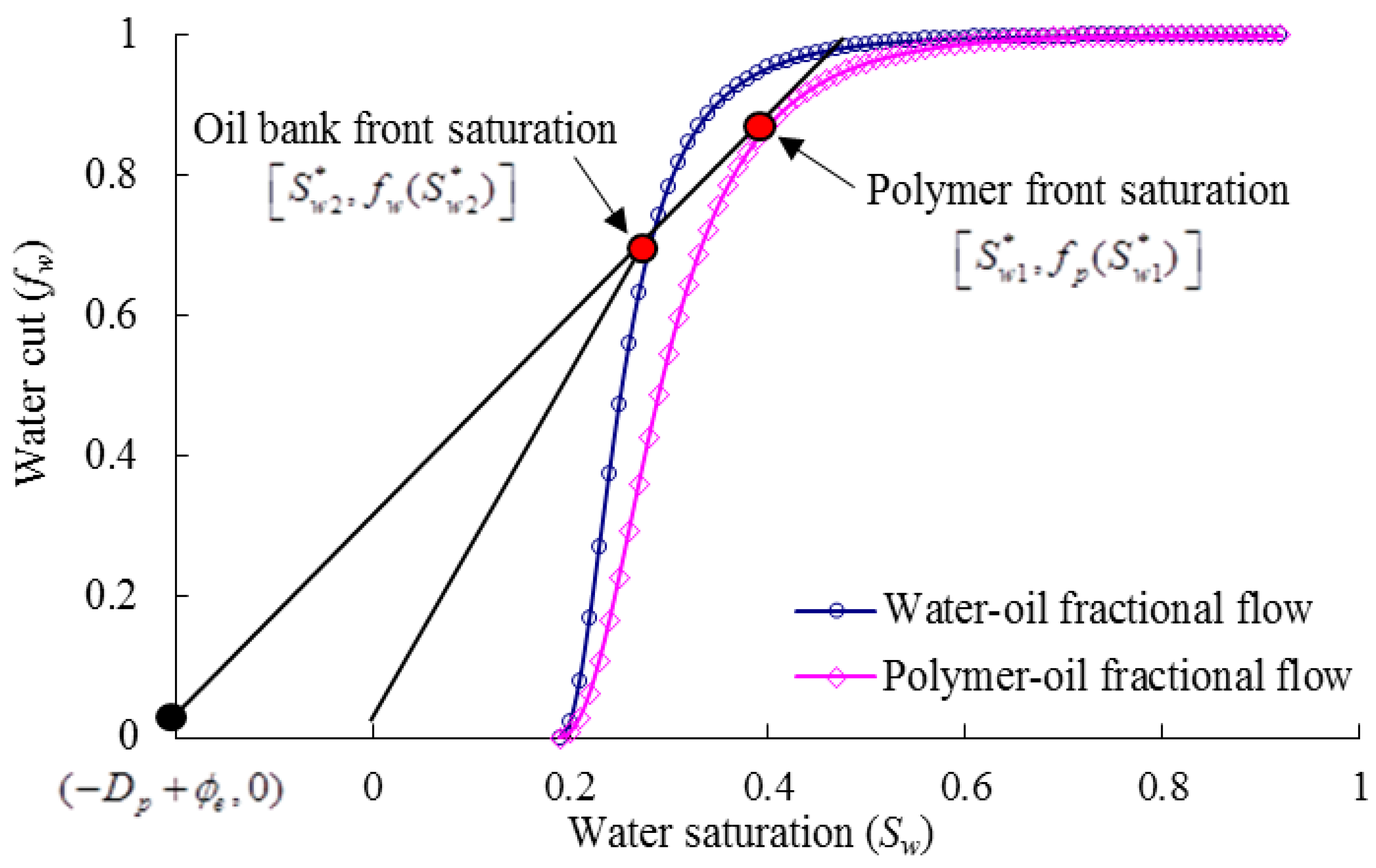
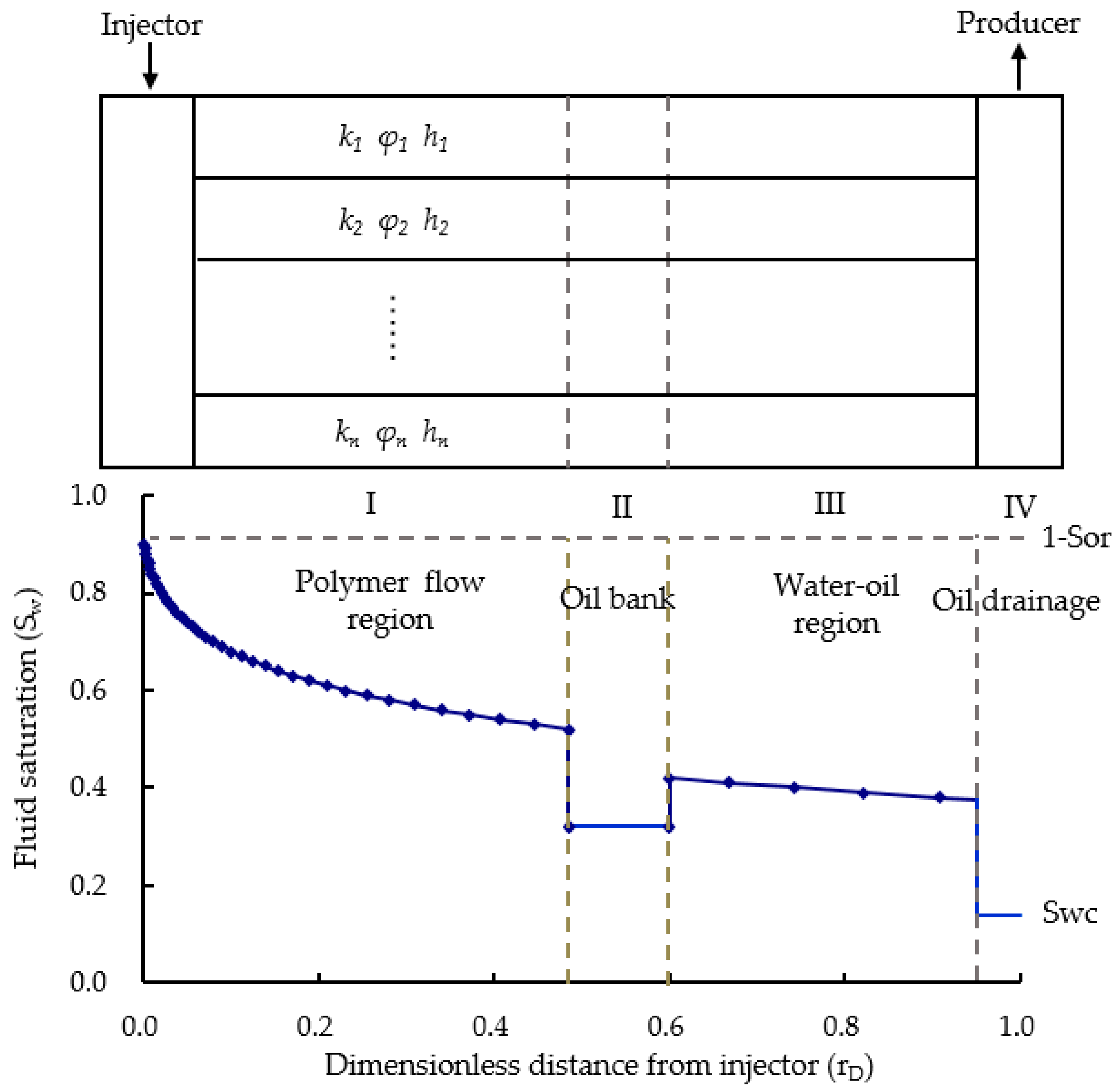

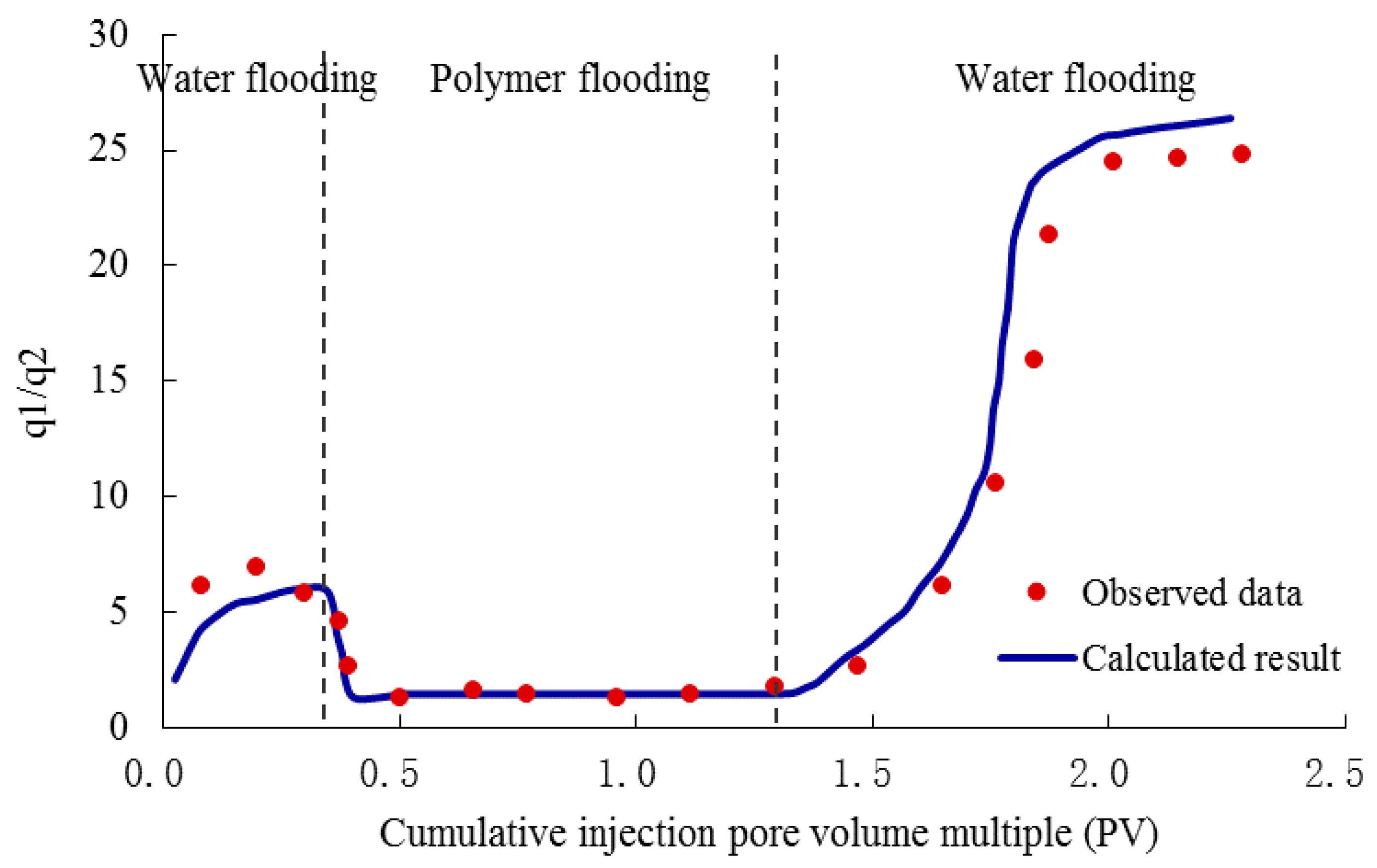
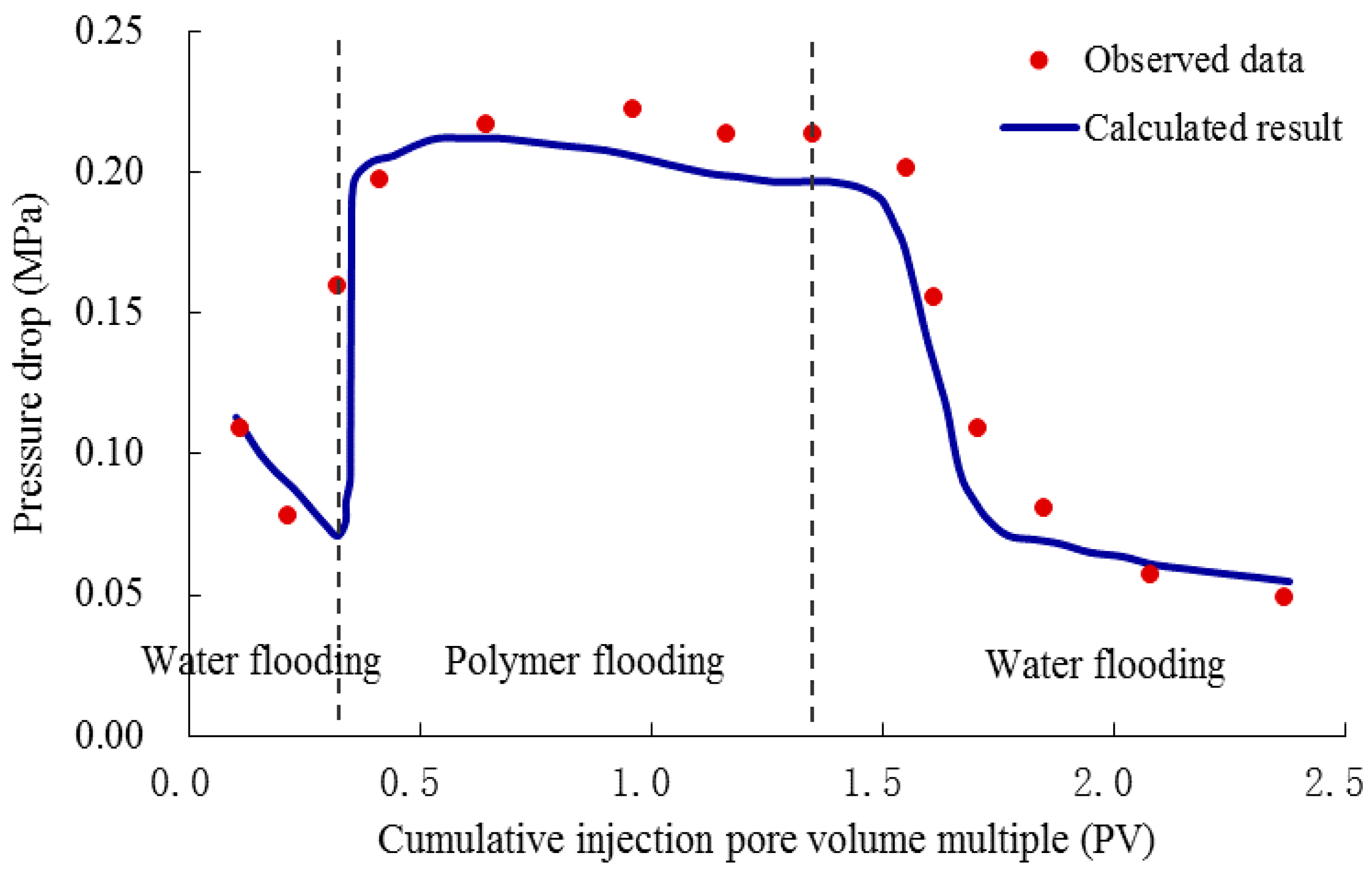
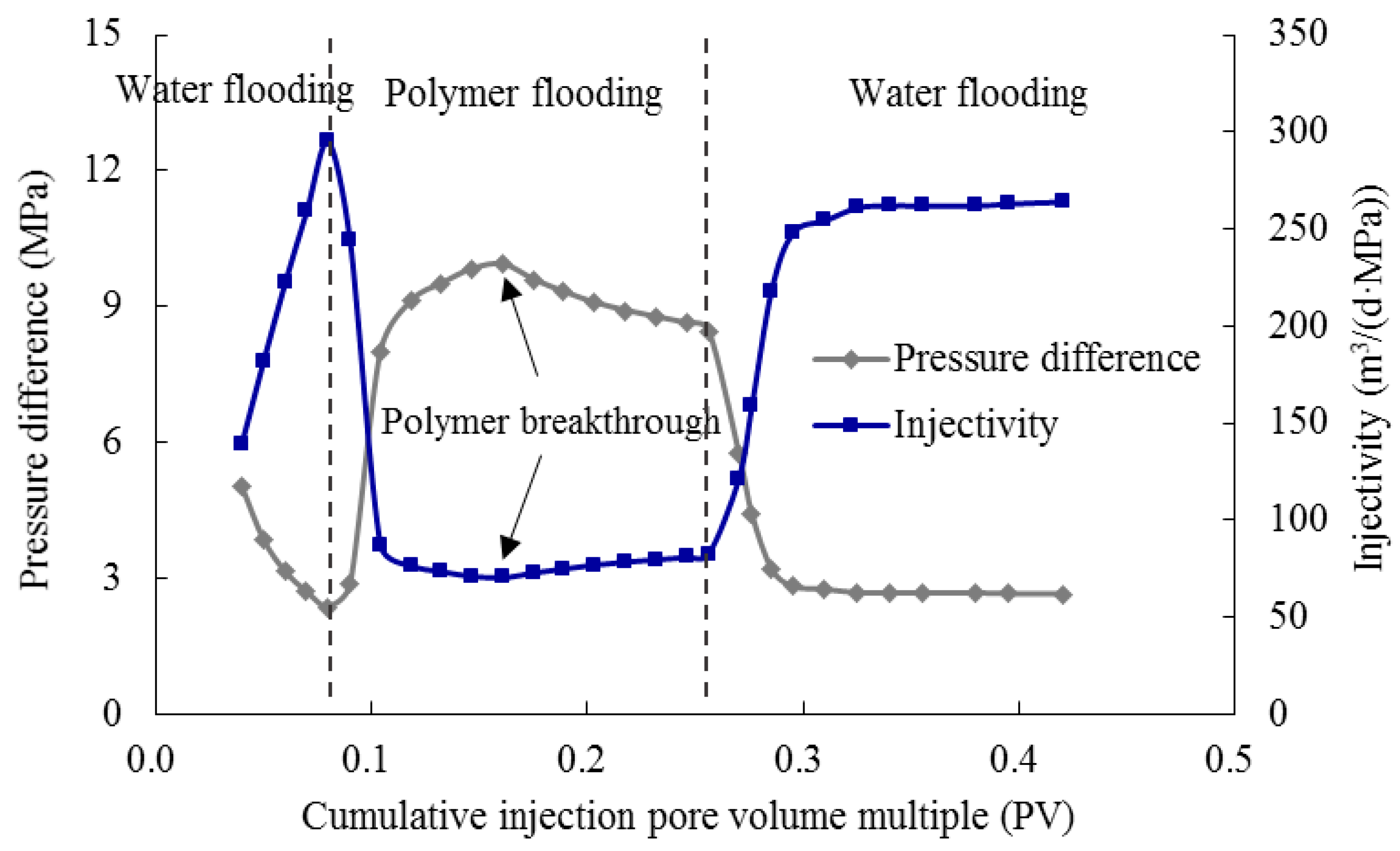
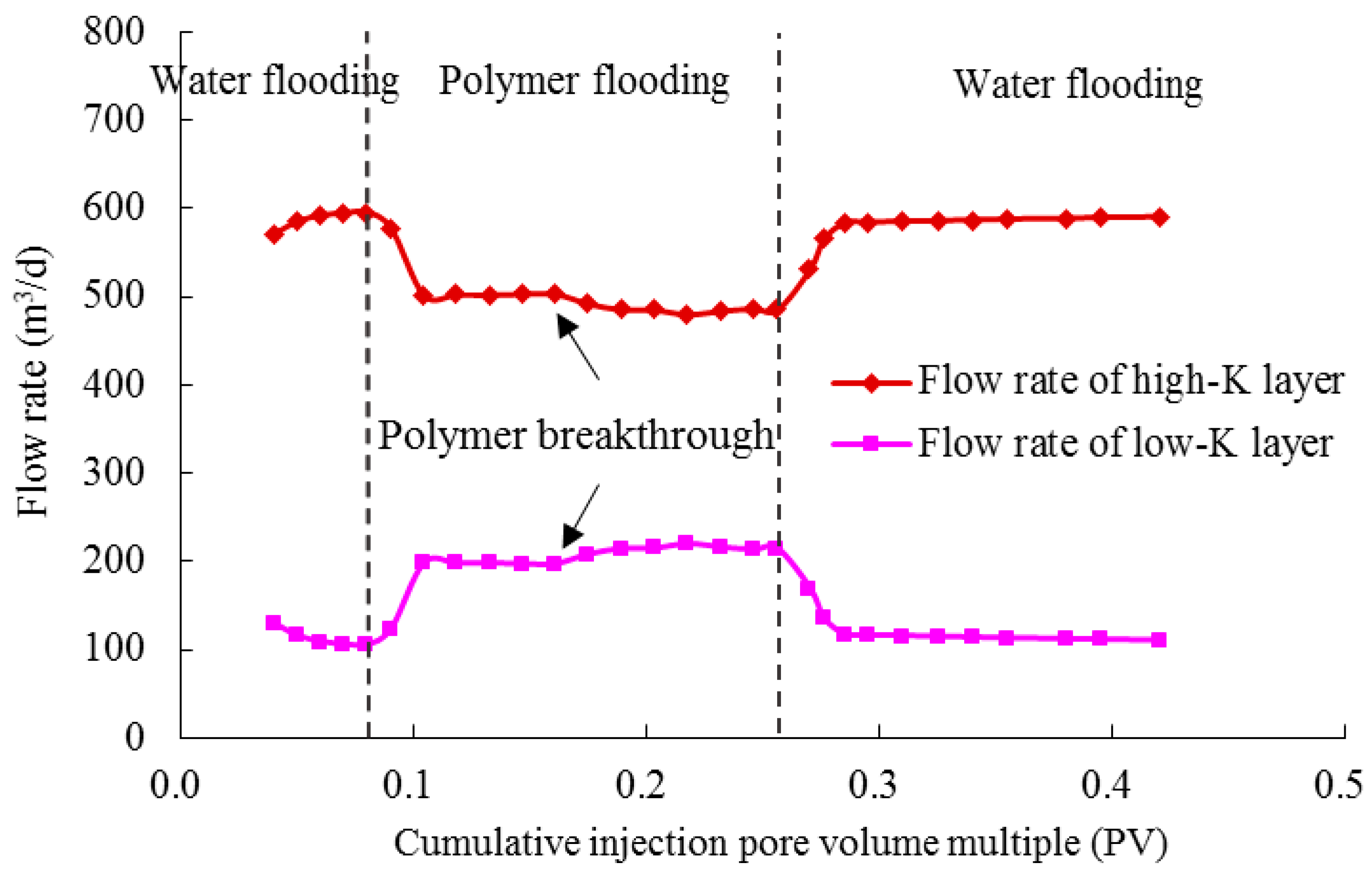
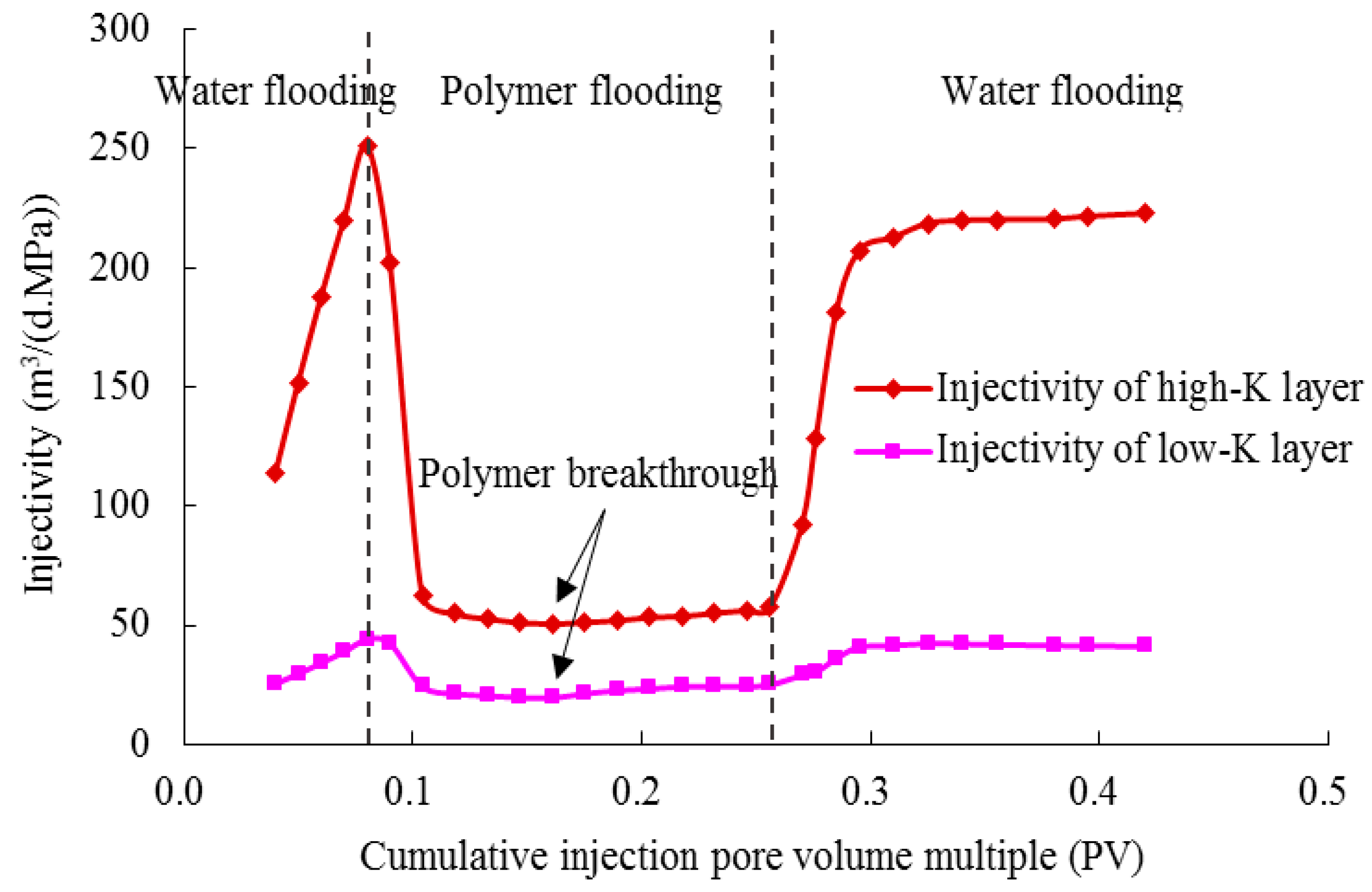

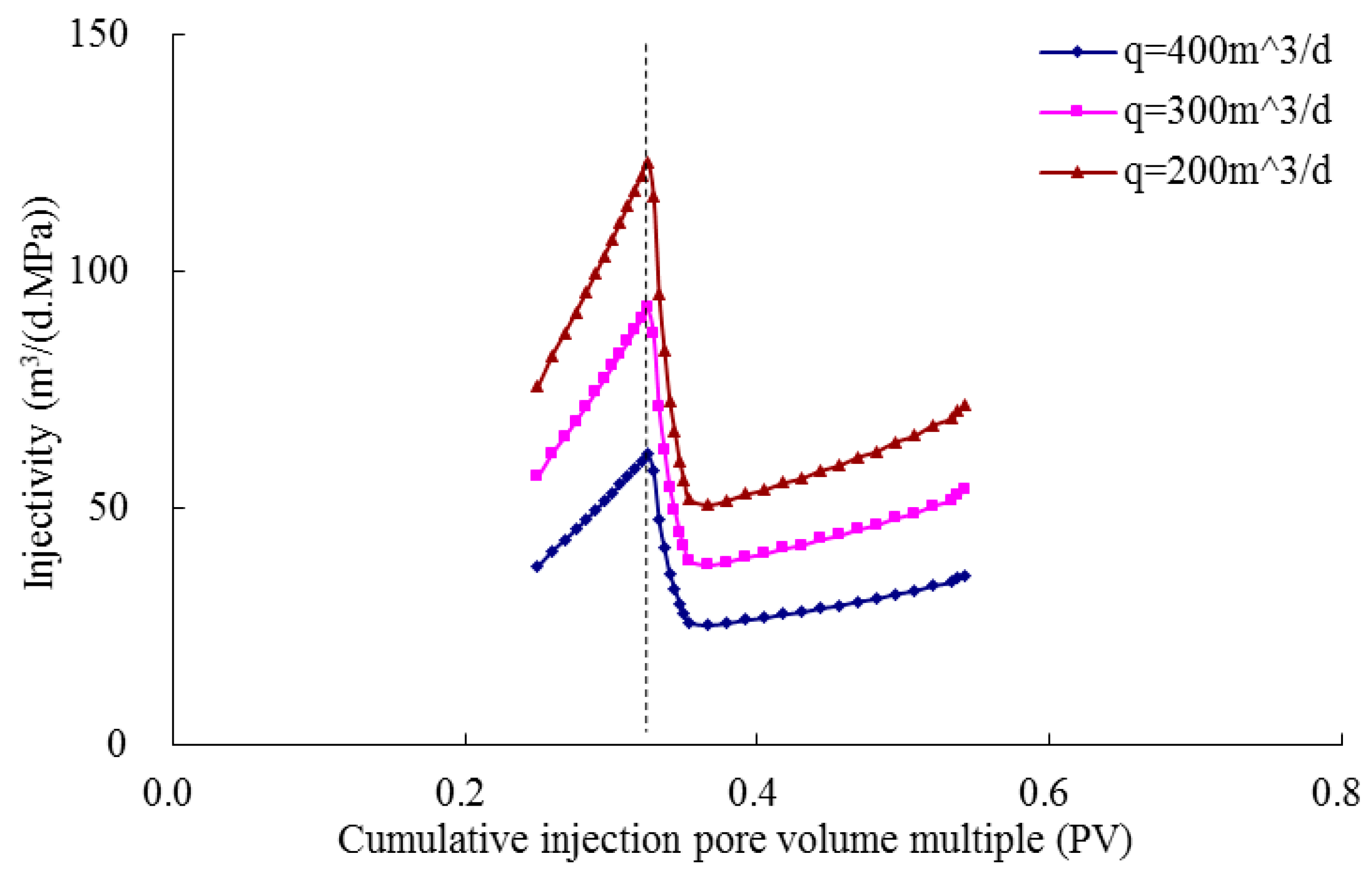
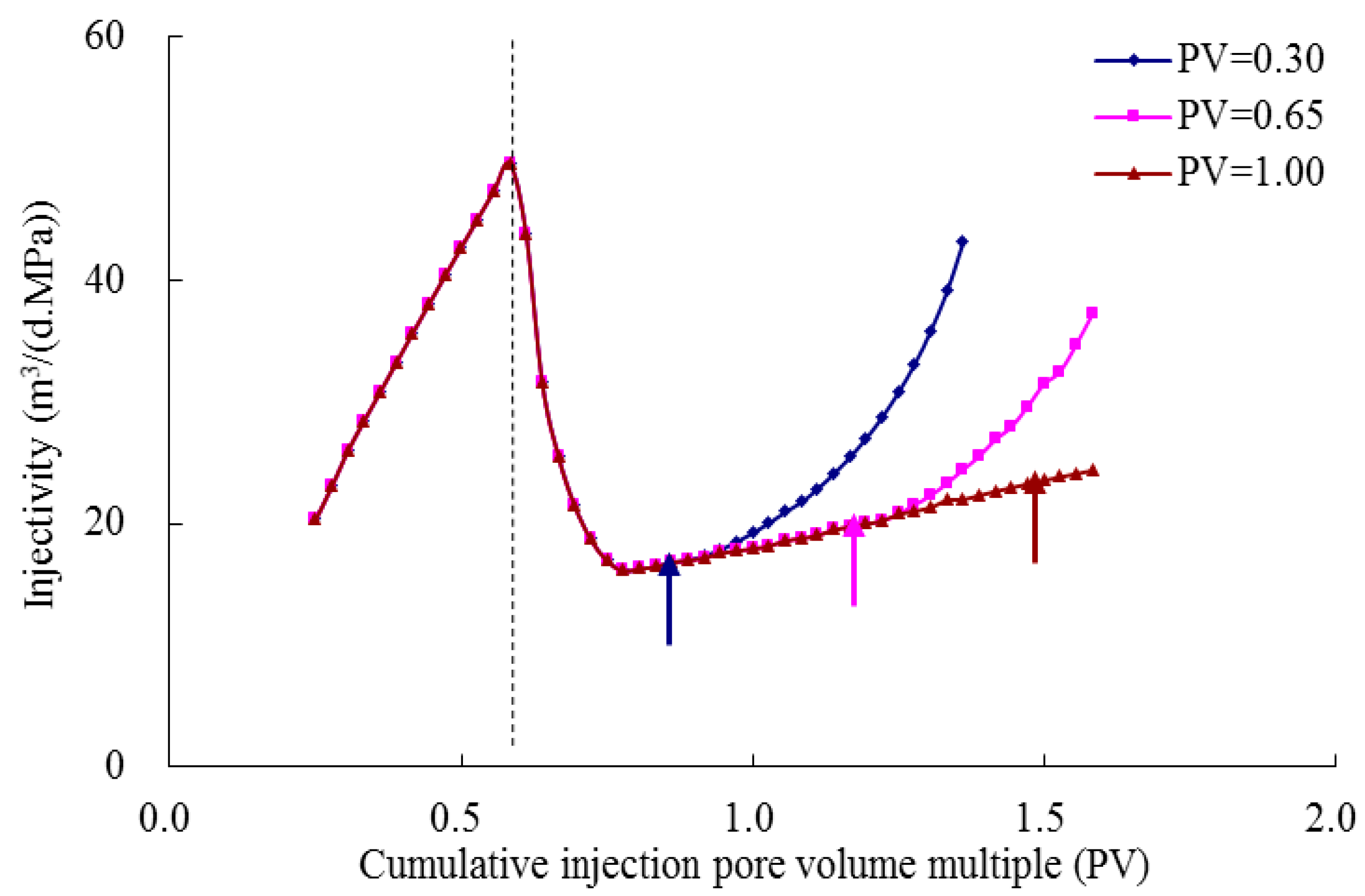
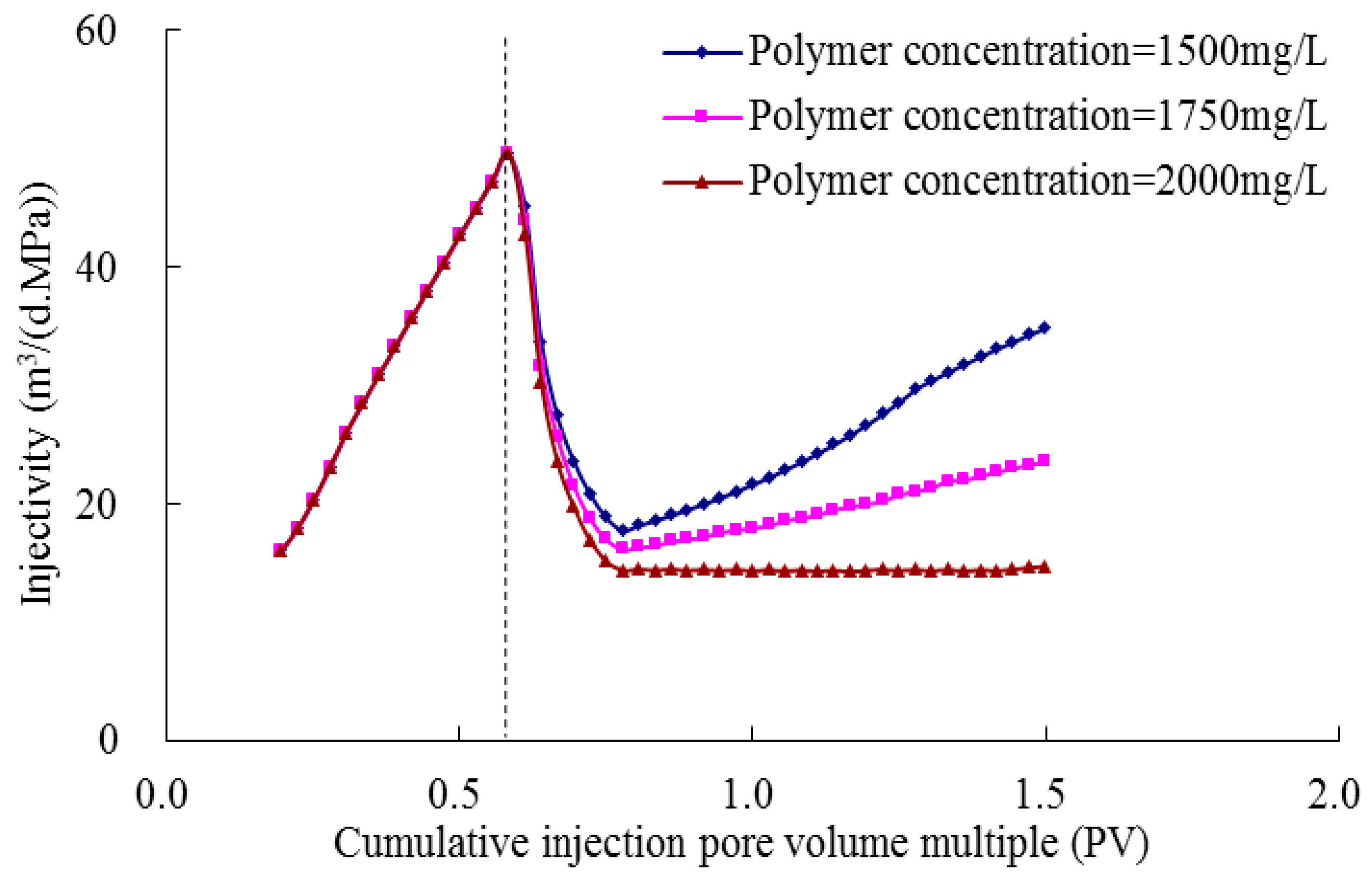
| Items | Value | |
|---|---|---|
| Core parameters (Units) | Length of No. 1 sand pack (cm) | 30 |
| Diameter of No. 1 sand pack (cm) | 2.5 | |
| Permeability of No. 1 sand pack (10−3 µm2) | 4023 | |
| Porosity of No. 1 sand pack (%) | 30 | |
| Length of No. 2 sand pack (cm) | 30 | |
| Diameter of No. 2 sand pack (cm) | 2.5 | |
| Permeability of No. 2 sand pack (10−3 µm2) | 1962 | |
| Porosity of No. 2 sand pack (%) | 28 | |
| Fluid parameters (Units) | Oil viscosity (mPa·s) | 70 |
| Water viscosity (mPa·s) | 0.49 | |
| Water salinity (mg/L) | 5855 | |
| Polymer viscosity (mPa·s) | 8 | |
| Polymer concentration (mg/L) | 1750 | |
| Pow law exponent (–) | 0.336 | |
| Inaccessible pore volume (–) | 0.18 | |
| Experiment parameters (Units) | Reservoir temperature (K) | 338 |
| Injection flow rate (cm3/min) | 1 | |
| Cumulative injected water volume in primary water flooding (PV) | 0.3 | |
| Cumulative injected polymer volume in secondary polymer flooding (PV) | 1.0 | |
| Cumulative injected polymer volume in subsequent water flooding (PV) | 1.0 | |
| Items | Value | |
|---|---|---|
| Geology parameters (Units) | Porosity (%) | 29 |
| Thickness of 1st layer (m) | 20 | |
| Permeability of 1st layer (10−3 µm2) | 3800 | |
| Thickness of 2nd layer (m) | 18 | |
| Permeability of 2nd layer (10−3 µm2) | 1900 | |
| Fluid parameters (Units) | Oil viscosity (mPa·s) | 70 |
| Water viscosity (mPa·s) | 0.49 | |
| Polymer concentration (mg/L) | 1750 | |
| Polymer viscosity (mPa·s) | 8 | |
| Power law exponent | 0.336 | |
| Inaccessible pore volume (–) | 0.18 | |
| Production parameters (Units) | Well pattern (–) | Five-spot |
| Well spacing (m) | 365 | |
| Bottom hole radius (m) | 0.1 | |
| Injection rate (PV/a) | 0.03 | |
| Cumulative injected water volume in primary water flooding (PV) | 0.08 | |
| Cumulative injected polymer volume in secondary polymer flooding (PV) | 0.18 | |
| Cumulative injected polymer volume in subsequent water flooding (PV) | 0.16 | |
© 2019 by the authors. Licensee MDPI, Basel, Switzerland. This article is an open access article distributed under the terms and conditions of the Creative Commons Attribution (CC BY) license (http://creativecommons.org/licenses/by/4.0/).
Share and Cite
Sun, L.; Li, B.; Jiang, H.; Li, Y.; Jiao, Y. An Injectivity Evaluation Model of Polymer Flooding in Offshore Multilayer Reservoir. Energies 2019, 12, 1444. https://doi.org/10.3390/en12081444
Sun L, Li B, Jiang H, Li Y, Jiao Y. An Injectivity Evaluation Model of Polymer Flooding in Offshore Multilayer Reservoir. Energies. 2019; 12(8):1444. https://doi.org/10.3390/en12081444
Chicago/Turabian StyleSun, Liang, Baozhu Li, Hanqiao Jiang, Yong Li, and Yuwei Jiao. 2019. "An Injectivity Evaluation Model of Polymer Flooding in Offshore Multilayer Reservoir" Energies 12, no. 8: 1444. https://doi.org/10.3390/en12081444




